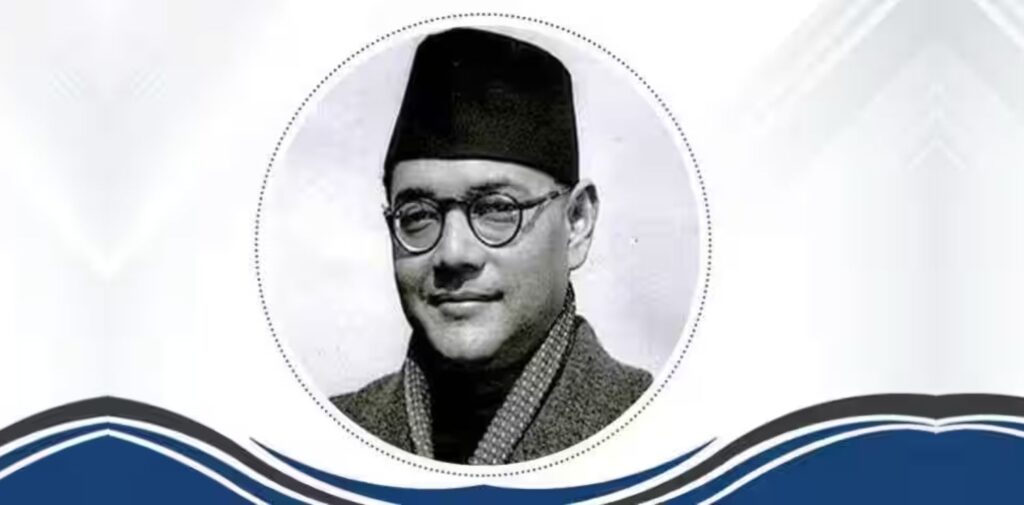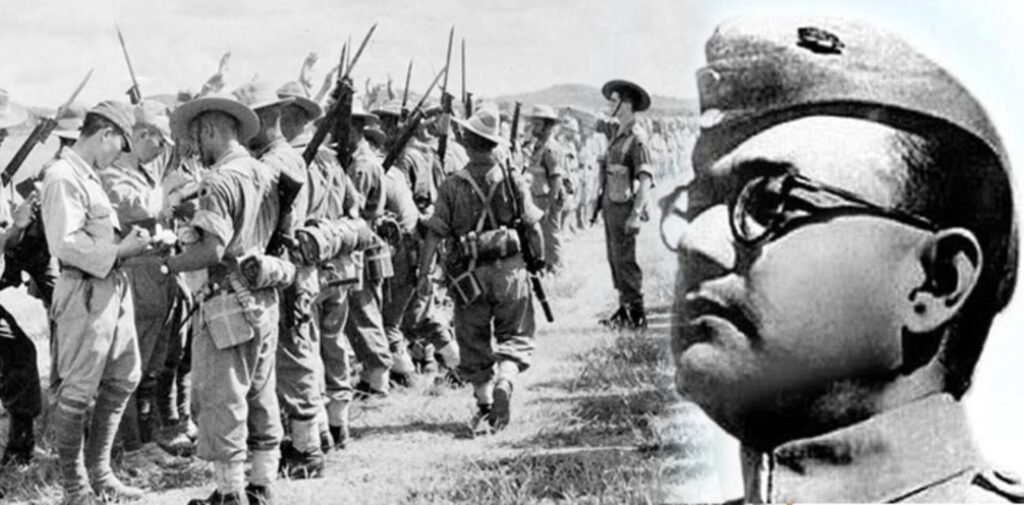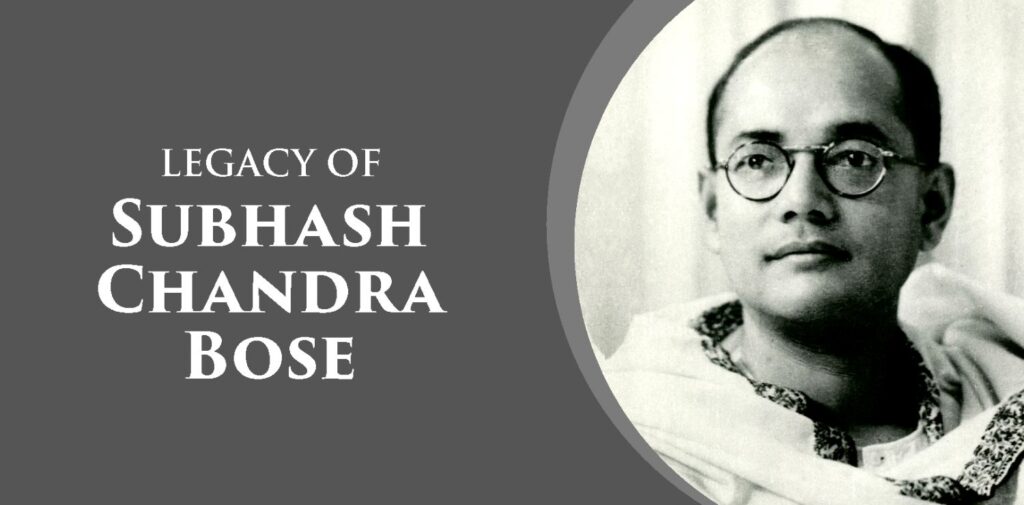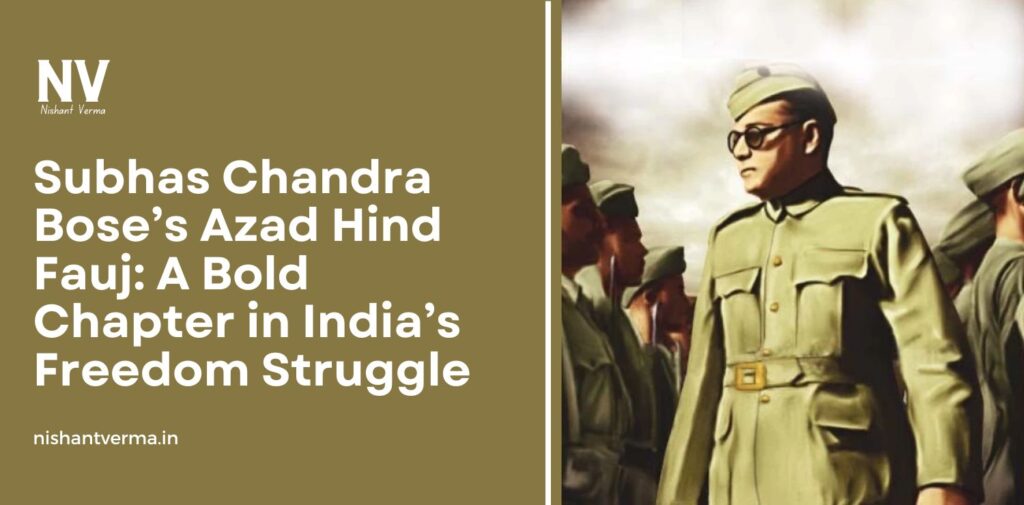Subhas Chandra Bose, one of India’s most dynamic and courageous freedom fighters, played an essential role in the struggle for India’s independence. His contribution, especially through the creation of the Azad Hind Fauj (Indian National Army or INA), marked a turning point in the freedom movement. While many leaders of the Indian National Congress, including Mahatma Gandhi, believed in non-violent resistance, Bose took a different route. He believed that India could only achieve independence through a decisive and strong military effort, and the formation of the Azad Hind Fauj was the embodiment of that belief.
This article explores about Subhas Chandra Bose Azad Hind Fauj, and its significance in India’s fight for freedom.
Subhas Chandra Bose’s Early Life and Ideology
Subhas Chandra Bose was born on January 23, 1897, in Cuttack, Odisha. He was a brilliant student and excelled in academics. He later went to England for higher studies and joined the Indian Civil Services. However, Bose’s deep love for his country and his desire to see it free from British colonial rule led him to resign from his prestigious civil service post in 1921.
Bose’s early years in India’s freedom struggle were marked by his association with the Indian National Congress (INC). Initially, he aligned with Mahatma Gandhi and worked closely with Jawaharlal Nehru, but his aggressive stance on India’s freedom differed from Gandhi’s non-violent approach. Bose strongly believed that India needed an organized, military response to challenge British rule and that peaceful methods alone would not be enough to bring about true freedom.

The Need for Armed Resistance
By the late 1930s, the Indian National Congress had become more actively involved in the struggle for independence. However, Gandhi’s philosophy of non-violence and his leadership overshadowed more aggressive approaches. Subhas Chandra Bose grew frustrated with the lack of progress and the slow pace of India’s struggle for freedom. He felt that the British would never leave India willingly through peaceful protests alone.
Bose realized that India needed to confront British rule directly. He argued that only an armed force could challenge the might of the British Empire. This led to his decision to take a more radical and militant approach, which culminated in the formation of the Azad Hind Fauj.
The Formation of Azad Hind Fauj
Subhas Chandra Bose’s vision of a free India had always been linked to military action. In 1941, while in exile in Europe, he sought help from the Axis powers (Germany and Japan) during World War II. He believed that by aligning with these powers, he could receive the support needed to form an army that would fight the British in India.
In 1942, Bose traveled to Southeast Asia, where he found a strong base of support among Indian expatriates and prisoners of war (POWs). With the help of Japan, Bose established the Azad Hind Fauj, also known as the Indian National Army (INA). He brought together Indian soldiers who had been captured by the Japanese during World War II and turned them into the core of the INA.
The Azad Hind Fauj was not just a military force; it was a symbol of hope and resistance for millions of Indians under British rule. Bose’s leadership of the INA inspired countless Indians to believe that freedom was not only possible, but it could be achieved through strength and determination.

The INA’s Role and Achievements
The Azad Hind Fauj was primarily formed to fight the British colonial forces in India. Under Bose’s leadership, the INA was trained and equipped by the Japanese in Southeast Asia. The army’s objective was to march to India and liberate the country from British rule.
One of the INA’s most significant achievements was its role in the Burma Campaign during World War II. The INA fought alongside the Japanese army and captured several regions in Burma (now Myanmar). Although they were not able to penetrate deep into India, their presence in Southeast Asia symbolized the growing resistance against British rule.
The INA also had a political arm, known as the Provisional Government of Free India, led by Bose. This government, established in 1943, was based in Singapore and was recognized by Germany, Japan, and Italy as the legitimate government of India. It aimed to gain international recognition for India’s independence and to rally support for the INA’s military efforts.
The INA’s most famous military action took place in 1944 when they launched an assault in the Indian province of Manipur. Although they were ultimately defeated by British forces, the INA’s actions were symbolic in showcasing the determination and spirit of the Indian people to fight for their freedom.
The INA and Indian Public Opinion
Although the INA did not succeed in its military campaigns, its efforts had a profound impact on India’s freedom movement. Bose’s bold leadership and the formation of the INA ignited a sense of nationalism and unity among Indians. The idea of an armed struggle against the British gained popularity, and many saw the INA as a beacon of hope for India’s independence.
The British government, aware of the growing support for the INA, decided to prosecute the captured INA soldiers after the end of World War II. In 1945, several INA officers were tried in a military court in India, which led to widespread protests across the country. The trial of INA officers became a turning point, as it united people from all walks of life against British rule.
The British attempt to prosecute the INA members backfired. Large-scale protests broke out, and the demand for India’s independence reached a fever pitch. The trials also brought attention to the sacrifices made by the INA soldiers and elevated Subhas Chandra Bose to the status of a national hero.

Subhas Chandra Bose’s Legacy
Subhas Chandra Bose’s impact on the Indian independence movement is immeasurable. While he did not live to see India gain independence, his efforts through the Azad Hind Fauj and his tireless advocacy for a military solution to British colonialism greatly accelerated the end of British rule.
His vision of a free and self-reliant India left a lasting legacy. Bose’s radical ideas on nationalism, unity, and independence resonated with generations of Indians. Even today, he is remembered as one of the greatest freedom fighters of India, a leader who was not afraid to take bold, unorthodox steps to secure his country’s freedom.
Though the INA did not succeed militarily, it marked a significant shift in India’s struggle for independence. Bose’s call for armed resistance, combined with the non-violent methods of leaders like Gandhi, created a multi-faceted approach to independence. His efforts proved that India would never give up in its quest for freedom, whether through diplomacy, protest, or armed struggle.
Conclusion: Subhas Chandra Bose Azad Hind Fauj
Subhas Chandra Bose and the Azad Hind Fauj represent one of the most important chapters in India’s journey to freedom. Bose’s leadership in the formation of the INA inspired many to believe in the power of resistance and the possibility of defeating British rule. His unwavering determination, charisma, and ability to rally millions of Indians to the cause of independence left a lasting impact on the country’s freedom movement.
Though the Azad Hind Fauj was ultimately unsuccessful in its military objectives, its legacy lives on in the collective memory of India. Bose’s vision of a free, united, and strong India continues to inspire people worldwide who believe in the power of resistance against oppression. His life and work remind us that the path to freedom is not always smooth, but it is always worth fighting for.




